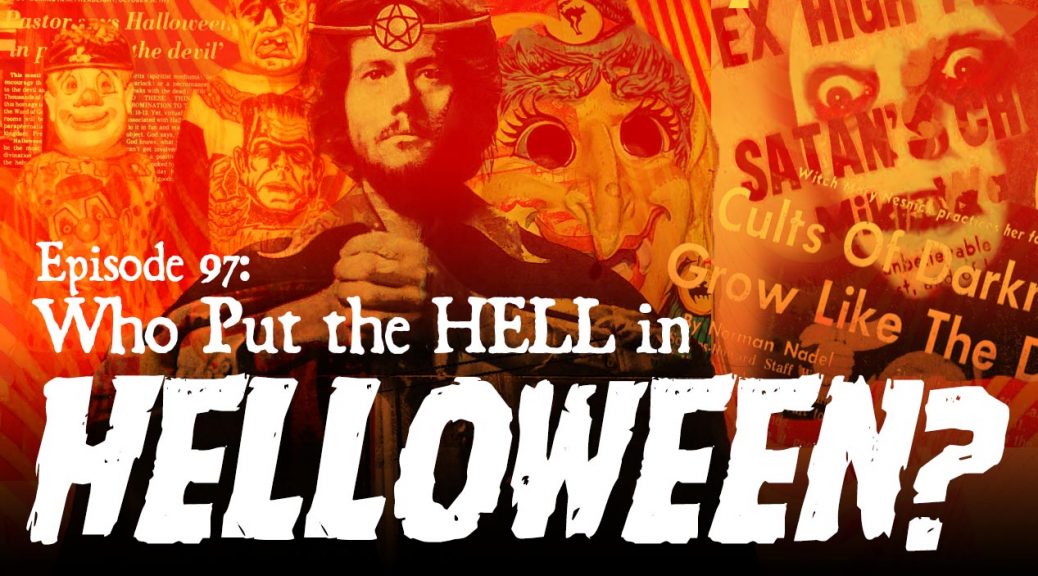
Who Put the Hell in Helloween?
Podcast: Play in new window | Download (Duration: 57:48 — 66.2MB)
Subscribe: Apple Podcasts | Spotify | Android | Podchaser | RSS | More
During the Satanic Panic, the notion of Halloween as a Satanic High Holy Day came to prominence, but the elements necessary to this mythology were set in place much earlier.
This episode focuses particularly on the early years of Wicca, some missteps in disassociating the movement from Satanism, and early evangelical personalities spinning “ex-Satanist” yarns from this material, which is to say, we focus particularly on the 1960s Occult Revival up to and including 1973. To set the mood for the era’s pop occultism, we hear some audio snippets by records released by witches, Louise Huebner, Gundella the Green Witch, Barbara the Gray Witch, and Babetta, the Sexy Witch.

We first have a quick look at Anton Lavey’s creation of The Church of Satan in 1966. While this sketched out cartoonish tropes of the Panic narrative, Lavey’s carnival-barker style and insistence that there was no actual Satan in his school of Satanism, undermined the influence he might have among all but the most credulous and paranoid.
The real roots of the Panic lay not in Lavey’s publicity stunt, which in the wider historical context was a mere flash in the pan, but in a much older idea conceiving witchcraft and Devil worship or traffic with demons, a notion that held sway for more than seven centuries and therefore not to be quickly rooted out by modern Wiccans.
Some of the sticking points here are rooted in 19th and early 20th century writings on witchcraft by the American folklorist Charles Leland and British Egyptologist Margaret Murray, and their “witch-cult” concept regarding witchcraft as an underground survival of ancient pagan religion. Problematic here too were their identification of the deities of this religion as “Lucifer” (Leland) and “The Horned God” (Murray).
We then turn to Gerald Gardner, the British civil servant, who in his retirement got the whole Wiccan ball rolling, declaring in the early 1950s, that he had been initiated into the ancient mysteries of this witch-cult by members of a surviving Coven in the New Forest region. In particular, we examine the way in which Gardner’s emphasis on UK traditions within Wicca, strengthened an association between Halloween and witches (despite virtually no mention of witch gatherings actually occurring on Halloween in earlier historical writings).

We then have a brief look at Sybil Leek, first acolyte of Gardnerian Wicca in the US, and darling of 1960s journalists. (Leek was profiled in our 2019 Halloween episode, “All of Them Witches.”) As the United States was the birthplace of the modern Halloween, Leek’s insatiable engagement with the press around that time, did much to strengthen the idea of Halloween as a singularly important time for witch gatherings and ritual. She also provides Halloween recipes!
By the 1960s, Wicca had branched into two paths, Gardnerian and Alexandrian, the latter named for the British witch Alex Sanders, who with his wife Maxine, headed a coven in London. Sanders has much to do with continued confusion between Wicca and Devil-worship thanks to his indiscriminate pursuit of media interest inclined to titillate audiences with the old diabolic model. We discuss his involvement with the British band Black Widow and their Satanic sacrifice stage-show, publicity involvement in the film Eye of the Devil (1966) , and his feature role in the documentary Legend of the Witches (1970) and mondo “documentary” Secret Rites (1971).

Just as Wicca originated in the UK, only later to be embraced in the US. fraudulent ex-Satanist testimonies were first told in Britain. In 1970 Bristol-born Doreen Irvine began relating stories of her involvement in the occult, tales that took their final form in her 1973 publication From Witchcraft to Christ. We hear a bit of her tale of teenage street-life, drugs, and prostitution leading to Satanism, her claims to curious supernatural abilities, and her crowning as the “Queen of the Black Witches” on the Dartmoor moor. As well as her warnings about celebrating Halloween.
While the ex-Satanist narrative, never really caught on in the UK, it hit the big time with American Mike Warnke’s 1972 book purporting to document his experiences in Satanism, The Satan Seller.

While Warnke’s fraudulent stories garnered him celebrity in the early days of the modern evangelical movement, by the late 1970s, he had reinvented himself as a popular Christian comedian. He did, however, revisit the theme once the Satanic Panic got rolling, with the 1979 release of the album “A Christian Perspective on Halloween.”
We hear his Satan Seller narrative of a good Midwestern boy corrupted by drugs in a California college, eventual elevation to High Priest within global Satanic underworld, eventual self-destruction through drugs leading to a stint with the Navy, during which he’s saved. Along the way, are some bizarre details about his fingernails, strange ordinations in real-world sects, and eventual exposure and fall within the evangelical community.
Another evangelical making the rounds with ex-Satanist stories in in Warnke’s day was John Todd, who began spinning his yars tales around 1968 in Phoenix. We only briefly discuss Todd as he really hits his stride outside our timeframe, namely, in the late ‘70s when his story of involvement in a Satanic underworld reached its greatest audience via Jack Chick comics.
We wrap up the show with a look at some early collaborators with Warnke in the the occult fear-mongering business — David Balsiger, Morris Cerrullo, and Hershel Smith (AKA “the Skin Eater) as well as their collaboration on the legendary “Witchmobile,” an “anti-occult mobile unit” that roamed the US and Canada from 1972 to 1974.
